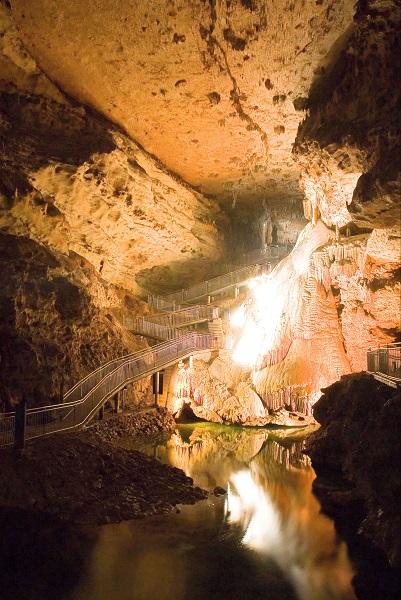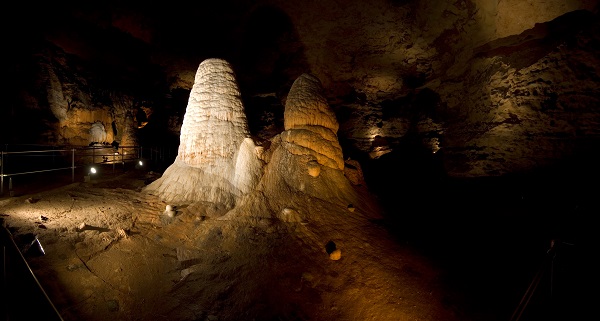at Onondaga Cave State Park
The Cave Park of the Cave State
 Missouri's natural beauty doesn't just lie above ground. Beneath its surface lies more than 5,500 caves and some of the state's most scenic natural wonders. Volcanic activity plus weather and water created a karst topography, which is characterized by sinkholes, underground streams and caverns. Some of the finest caverns in the state can be found at Onondaga Cave State Park.
Missouri's natural beauty doesn't just lie above ground. Beneath its surface lies more than 5,500 caves and some of the state's most scenic natural wonders. Volcanic activity plus weather and water created a karst topography, which is characterized by sinkholes, underground streams and caverns. Some of the finest caverns in the state can be found at Onondaga Cave State Park.
Millions of years ago, shallow seas that covered much of the Ozarks deposited layers of sediments, forming the limestone and dolomite bedrock that dominate the region today. Over time, the dissolving action of water along underground cracks formed large water-filled passages. On the surface, erosion began to cut stream and river valleys; as they deepened, they intersected and drained some of the underground passages, creating air-filled caves. Water can decorate the caves with carbonate deposits or speleothems.
Onondaga Cave is one of America's most spectacular caves because of the great abundance and quality of its speleothems or deposits. Stalactites, stalagmites, rimstone dams, flowstones, draperies, soda straws and cave coral extensively decorate the cave. Because of this, Onondaga Cave was designated as a National Natural Landmark. Many of the deposits are still growing, and a stream meanders through the cave in an entrenched canyon.
Around 1850, settlers began arriving in the Meramec River valley. The area's springs were used to power numerous gristmills, and the spring that flows from Onondaga Cave was dammed to power the Davis Mill. John Eaton and Charles Christopher first explored Onondaga Cave around 1886 by sinking a johnboat under the bluff at this mill site.
Onondaga Cave became popular as a tourist attraction during the 1904 St. Louis World's Fair. Visitors from St. Louis were brought to Leasburg by the Frisco Railroad, and then transported by wagon to the cave. Onondaga's fame as a tourist attraction increased during the 1950s and '60s under the ownership of Lester B. Dill. Careful to preserve the natural integrity of the cave, Dill expressed his wish that the cave be preserved as a state park. After Dill's death, the cave and surrounding acreage were purchased by The Nature Conservancy and subsequently transferred to the Missouri Department of Natural Resources.
A tour of Onondaga Cave should not be missed. Trained guides provide information about such geologic wonders as the Queen's Canopy, the Twins and the Lily Pad Room.
 During the summer season, nature programs are held for park visitors, including tours of the other spectacular cave in the park, Cathedral Cave.
During the summer season, nature programs are held for park visitors, including tours of the other spectacular cave in the park, Cathedral Cave.
Above ground, the park's visitor center contains displays and exhibits that showcase Missouri as the Cave State and explain the significance of Onondaga Cave. Located 5 miles from the park's main section is a 317-acre unit that contains Vilander Bluff Natural Area, which features some of the highest bluffs along the Meramec River. These towering dolomite bluffs provide a spectacular view of the Meramec River valley.
Picnic areas near the Meramec River, which borders the park, and an open picnic shelter that can be reserved make the park a great place for family gatherings. More than 6 miles of hiking trails are available, and the river provides opportunities for swimming, fishing and canoeing. The park's newly renovated campground opened in April 2004 and offers electric/water campsites as well as basic campsites with concrete pads.





